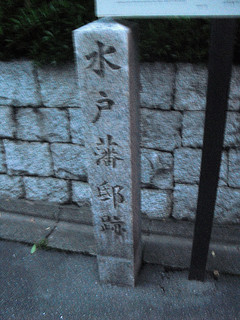Difference between revisions of "Mito Kyoto mansion"
(Created page with "right|thumb|320px|Stone marker at the former site of the mansion. *''Japanese'': 京都水戸藩邸 ''(Kyoto Mito hantei)'' In the [[Edo perio...") |
m |
||
| Line 4: | Line 4: | ||
In the [[Edo period]], [[Mito han]] maintained a mansion in [[Kyoto]] on the north side of Shimo-Chôjamachi-dôri, just west of Karasuma-dôri. Most ''[[han]]'' maintained [[daimyo yashiki|mansions]] in [[Kyoto]] during the [[Edo period]], as well as in [[Edo]]. Among other roles and purposes, the mansion served as an outpost for the domain's political and commercial activities in the [[Kamigata]] (Kyoto-[[Osaka]]) region. | In the [[Edo period]], [[Mito han]] maintained a mansion in [[Kyoto]] on the north side of Shimo-Chôjamachi-dôri, just west of Karasuma-dôri. Most ''[[han]]'' maintained [[daimyo yashiki|mansions]] in [[Kyoto]] during the [[Edo period]], as well as in [[Edo]]. Among other roles and purposes, the mansion served as an outpost for the domain's political and commercial activities in the [[Kamigata]] (Kyoto-[[Osaka]]) region. | ||
| − | The Mito han mansion appears in this located in a 1686 map. At the time when the mansion was dismantled, in the [[Meiji period]], it took up 1302 ''[[Japanese Measurements|tsubo]]'', or roughly 4300 square meters. Mito han was one of the [[Gosanke]] (Three Branch [[Tokugawa clan|Tokugawa]] Houses), with the first lord being [[Tokugawa Yorifusa|Yorifusa]], son of [[Tokugawa Ieyasu]]. The domain was ranked at 330,000 ''[[koku]]''. The second lord of Mito, [[Tokugawa Mitsukuni]], began the ''[[Dai-Nihonshi]]'' ("History of Great Japan"), which continued to be worked on | + | The Mito han mansion appears in this located in a 1686 map. At the time when the mansion was dismantled, in the [[Meiji period]], it took up 1302 ''[[Japanese Measurements|tsubo]]'', or roughly 4300 square meters. Mito han was one of the [[Gosanke]] (Three Branch [[Tokugawa clan|Tokugawa]] Houses), with the first lord being [[Tokugawa Yorifusa|Yorifusa]], son of [[Tokugawa Ieyasu]]. The domain was ranked at 330,000 ''[[koku]]''. The second lord of Mito, [[Tokugawa Mitsukuni]], began the ''[[Dai-Nihonshi]]'' ("History of Great Japan"), which continued to be worked on into the [[Meiji period]]. In order to gather the materials to compile such a history, many officials were sent to Kyoto, and this mansion became the centre of their activities. The copying of texts they borrowed also took place here. In the Bakumatsu period, the han became divided between those loyal to the shogunate, and those of the ''[[sonno|sonnô]] [[joi|jôi]]'' ("revere the emperor, expel the barbarians") faction, and had a considerable impact upon the ''[[shishi]]'' (loyal patriots; anti-shogunate rebels) of the various provinces. |
A stone marker stands today on the former site of the mansion. | A stone marker stands today on the former site of the mansion. | ||
Revision as of 16:31, 3 November 2013
- Japanese: 京都水戸藩邸 (Kyoto Mito hantei)
In the Edo period, Mito han maintained a mansion in Kyoto on the north side of Shimo-Chôjamachi-dôri, just west of Karasuma-dôri. Most han maintained mansions in Kyoto during the Edo period, as well as in Edo. Among other roles and purposes, the mansion served as an outpost for the domain's political and commercial activities in the Kamigata (Kyoto-Osaka) region.
The Mito han mansion appears in this located in a 1686 map. At the time when the mansion was dismantled, in the Meiji period, it took up 1302 tsubo, or roughly 4300 square meters. Mito han was one of the Gosanke (Three Branch Tokugawa Houses), with the first lord being Yorifusa, son of Tokugawa Ieyasu. The domain was ranked at 330,000 koku. The second lord of Mito, Tokugawa Mitsukuni, began the Dai-Nihonshi ("History of Great Japan"), which continued to be worked on into the Meiji period. In order to gather the materials to compile such a history, many officials were sent to Kyoto, and this mansion became the centre of their activities. The copying of texts they borrowed also took place here. In the Bakumatsu period, the han became divided between those loyal to the shogunate, and those of the sonnô jôi ("revere the emperor, expel the barbarians") faction, and had a considerable impact upon the shishi (loyal patriots; anti-shogunate rebels) of the various provinces.
A stone marker stands today on the former site of the mansion.
References
- Plaques on-site.
